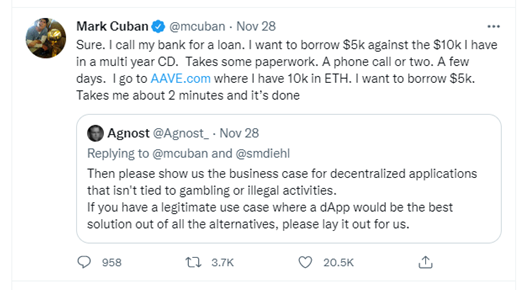

Date: 12/03/2021
Author: Mr. X
Mark Cuban took to Twitter to defend cryptocurrency and its practical uses earlier this week.


“Trying actually using defi applications,” [SIC] he tweeted later. There was a great deal of skepticism in the comments. For many, cryptocurrency remains a speculative asset. The point is to buy coins or tokens and flip them. Outside of a few developers, who actually uses them?
There are more people than you might think. In fact, the growth is nothing short of staggering. On January 1, 2021, there were about one million crypto addresses (which we can assume to be individual users, more or less) involved with the major DeFi (decentralized finance) projects. By late July, DeCrypt reported that the number had increased to more than 3 million. By the end of the year, we can expect millions more.
Yet the marketplace still remains dangerous. Even as this is written, the DeFi platform BadgerDAO suffered a catastrophic theft, with an estimated $120 million in tokens being stolen. Much of this may be reclaimed, but it is obviously too early to say.
Bitcoin, now legal currency in El Salvador, is firmly mainstream. (For reference, Bitcoin with a capital B refers to the Bitcoin blockchain, while the currency is bitcoin with a lowercase b). It is no longer that unusual to use it for donations or transactions, though most people probably hold it as a store of value. It has surged during the pandemic, outperforming gold by about 10 times in 2020 and as of November, utterly crushing the yellow metal in 2021. Gold is actually down so far this year.
The Ethereum blockchain and its token ether is rapidly approaching Bitcoin’s market cap. The day that Ethereum overtakes Bitcoin in market cap is known as “The Flippening.” The Ethereum blockchain has received several updates and modifications over the last few years, with the greatest one scheduled to take place in 2022. At that point Ethereum will operate on the “Proof of Stake” model rather than the energy-intensive “Proof of Work” model.
For most investors, you might just want to limit yourself to the big two. Bitcoin is digital gold and Ethereum 2.0, which should greatly reduce “gas prices” (the costs for carrying out transactions) and make the network operate more smoothly, will be used for applications.
Yet there are other blockchains out there that objectively outperform the big two when it comes to utility. We aren’t even going to talk about the newest and most innovative because this is an area you should enter with caution. Cryptocurrency is highly volatile, because a theft or a market move by a “whale” (large investor) can cause huge swings in price.
Still, this sector is only going to grow, especially as current governments seem unable to control inflation and distrust of mainstream financial institutions (and institutions generally) increase. Therefore, let’s look at three cryptocurrencies that have been surging recently and why you should care about them.
First, and probably the most important, is Polkadot (DOT). Polkadot allows different blockchains to communicate and interact with each other. This permits direct swaps between investors and potentially dispenses with the need for exchanges. It can also process transactions far more quickly than Ethereum, and potentially more quickly than Ethereum 2.0.
Polkadot also has formed partnerships with several other crypto projects, notably Chainlink (LINK). In October, the Associated Press announced that it was partnering with Chainlink to provide verified information to blockchain users. Chainlink allows off-blockchain information to be paired with smart contracts on the blockchain. Polkadot, in turn, can then allow this blockchain to be used in other transactions or apps. This is just one example of the limitless partnerships Polkadot can forge.
DOT has surged by more than 500% over the last year, but it has plunged by more than 30% over the last month. Polkadot’s approach to “sharding,” a way to process transactions more quickly, is superior to Ethereum’s. It will likely remain superior even after Ethereum 2.0 is fully unveiled. Yet the question is whether DOT will be able to overcome Ethereum 2.0’s larger market share over the long run. Polkadot’s true value may lie in its ability to be a “blockchain of blockchains,” connecting various projects in what is currently a frustrating, segregated sector. If blockchain technology is ever to be really used, instead of just serving as a source of speculation, interoperability is a must.
What’s the danger for DOT? Given that it doesn’t have nearly the market cap of Ethereum, its advantage is simply that it can do something Ethereum and Bitcoin can’t. However, that means Polkadot is vulnerable to other developers in a way the Big Two simply aren’t.
Cardano (ADA) is a sizable presence in the cryptocurrency market. As of this writing, it was the sixth-largest by market cap. It’s up more than 900% this year and blows Ethereum away when it comes to processing transactions. Cardano unveiled smart contract functionality in September, relatively late, but as part of a deliberately cautious plan that developers are following. Since then, decentralized applications (dApps) have surged on the network, especially when it comes to DeFi.
Still, it’s Solana (SOL) that’s creating the headlines recently. Grayscale Solana Trust debuted on Tuesday, which helped the network gain credibility. Solana is debuting features more quickly than Cardano. Non-Fungible Tokens (NFTs) have been especially popular on Solana, with Solanart (currently in beta mode) becoming a major marketplace for NFT traders.
What makes Solana different? It processes transactions faster than Bitcoin or Ethereum, but that doesn’t make it particularly special in the blockchain sector. Its Proof of Stake model also isn’t novel. What’s different is its complimentary Proof of History mechanism. This allows transactions to take place more quickly by reducing the amount of data validator nodes need to process. Currently, Solana is faster than Cardano. While Cardano has future upgrades planned to increase its speed, Solana can currently execute thousands of transactions per second at a relatively low cost per transaction. For comparison’s sake, Ethereum can only handle a few dozen per second – sometimes.
On Rogue Investing Daily, I put myself out there twice when it comes to Solana. On October 15, I predicted it would hit $200 by the end of the year from its current price, which it did soon afterward. On October 26, I said it would hit $250 before the end of the year. It’s currently above $230. We’ll see if I’m right in less than a month.
An Information Service That Takes You Inside the Corridors of Power
SOL has increased by well over 10,000% over the last year. That should make you excited… but also cautious. Much of this could be driven by NFTs, which some see as a bubble. Solana’s approach of simply storming out of the gate (compared to Cardano’s more stately approach) has given it a key advantage here. Your opinion on NFTs and their value will have a great impact on your views about Solana.
If you are going to step beyond the Big Two, do so cautiously. The best way to do it would be to purchase a small amount of these tokens not as investments but so you can explore the ecosystem that is being created on each network. The ease, speed, and variety of DeFis, NFTs, games, and other projects you will find should give you a feel for what works best. That should inform your decision.
There are of course far more tokens than just these three… and the spectacular gains in price lie in much smaller altcoins that few are talking about now. Of course, most of those smaller altcoins may prove to be worthless. With these larger networks that have proven their worth (at least for now), the key is to study utility. What can you actually use these networks for?
If, like Mark Cuban’s critics, you don’t actually find yourself interested in such projects, there’s no shame in limiting yourself to Bitcoin and Ethereum. That said, I’d encourage you to explore this world, not as a speculator, but as a participant in these and other networks. Doing so will help you better understand blockchain technology, evaluate different protocols, and predict which coins are likely to surge in value.
Doing this will take time – the one thing money can’t buy. Yet experience in this world will pay off, as different networks will increasingly be spoken of in terms of what they can do. That’s where this technology’s true value lies – not just in what some token is worth on some exchange.
Mr. X is an investment analyst working in the Washington DC area who specializes in the intersection of business and public policy. After fifteen years working in politics, he writes on a classified basis for RogueInvesting.com three times a week to bring you news on what those with power are debating, planning, and doing.







